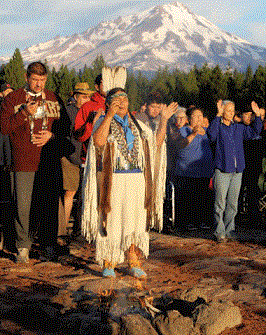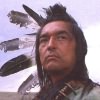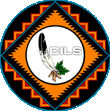
Hosted free by tripod.com
|
What the Indian wants is not so complicated, nor is it so different from what other Americans want. He wants to be himself, to protect his family and his heritage from harm, to make a living of his own choosing, and to select the men who will govern the intimate aspects of his daily life. Until now, he has been prevented from doing the least, the most basic, of these fundamental activities. He fought on the battlefield and lost. He is still fighting today for the same things -- his homeland, his life as an Indian -- but now without weapons. Just as in the movies, he is losing again. He asks for weapons --- not guns or bombs or tanks-- but simply the means to make justice prevail. Is this America? If it is, then show us Indians that truth of Equality and Justice is fact, not just cheap talk.
In "The Tortured Americans" by Robt Burnette of the then Rosebud Sioux. [1971] |



The socalled Cottonwood Indians had existed for hundreds of years in this area prior to the coming of the Europeans. At the time of the arrival of the whites, the indigenous peoples had fairly definite areas of habitation, with the Yana (Nosa-Nozi) occupying the area east of the Sacramento River, and three general Wintun peoples occupying the area west of the river and into the foothills. Frémont named what we now know as Battle Creek "Nozi Creek" after these Yana people. Less observant whites frequently lumped them all together with the unfriendly epithet "Diggers."
Those who bothered to notice, however, have commented on major differences, not only in cultural characteristics, but phsyical traits as well. The Yana people, speaking Hokan languages, tended to be slender, and highly prized prowess and courage. They were known as fine hunters, and tended to be more nomadic than the riverine Wintu folk, with their settled rancherias. Unfortunately for the invading settlers, and even more unfortunately for themselves, they were also somewhat bellicose. This trait was all the excuse many whites needed to commit what in retrospect appears little less than "genocide."
Additionally, John Bidwell recorded that shortly before the grants to the former Yankees under Micheltoreña, an epidemic, thought to be small pox, wiped out large numbers of the mountain Indians (apparently Yana), who possibly contracted the white man`s disease from the trapping parties that came through during the late 1820s and 1830s. These parties would have included those of Jedediah Strong Smith, Alexander Roderick McLeod, Peter Skene Ogden, and John Work (or Wark).
What the Wintu spoke was (formerly classified as) a dialect of the Penutian language. They lived here in northwestern California in cone-shaped structures covered with bark. Their diet included salmon, trout, small game, as well as deer and bear; acorns, seeds, piñon nuts, and berries.
West of the Sacramento River, the Cottonwood Indians were middle Wintun, or Nomo Lacke, and were heavily dependent upon the yearly salmon runs of summer and fall, from which they made salmon flour (dy-ee) and various other staples. They did not put a premium upon raids and maraudings, though they resisted raids of aggressive tribes in the Yukan group to the southwest, and Yana to the east. They valued somewhat more domesticated arts, loved story-telling and dance, and had celebrations and festivities for numerous occasions.
[Note: the Wai Lacke, another branch of Wintu, were higher to the west, and up into what is now Trinity County.]
Alice Hoveman records that "one of the first non-Indians known to have ridden though Wintu territory was Jedediah Smith (1828)
Pierson B. Reading was positive, if paternalistic, regarding his impressions of these (Wintu) Cottonwood Indians. He wrote: "These Indians are quite different from any I have seen in the mountains or the prairies, being mild and inoffensive in their manner, and easily taught the various duties of the farm. There are on my land two villages, each number 150 persons, men, women and children. I am confident that by treating them kindly I can easily convert them into useful subjects, and at the same time improve their condition as human beings." [written Feb 1844]
Yet Benjamin Shurtleff, the first and only alcalde of Reading Springs (Old Shasta), still harbored the early prejudices against the pugnacious Yana which he referred to in 1900 as "thieving, murderous Indians." Shurtleff, otherwise apparently rather enlightened and civilized, was far more typical in his anti-Indian attitudes during the 1850s than the wise and benignant Major Reading. With the gold rush a much less enlightened and patient type of yapytoo, or white man, had come pouring into Wintu and Nomo Lacke lands. These were the 1850s and 1860s, and were terrible times for the native peoples. In a pow wow of sorts held between the Wintu and the miners, a white man recorded an Indian counterpart declaring, as they understood him:
"The white man takes the Indian`s hunting ground and his women and drives the Indian away. When the bad Indian steals from the white man, the white man kills all the Indians. The Indians can`t fight the white man. He don`t want to fight. He don`t want the gold. He wants the fish. He wants the game. He wants his hunting ground and his women and children. When the white man comes he takes all."
For the Nomo Lacke, being driven from their fishing sites was a calamity. It spelled, as Dottie Smith observes, terrible years, hungry years. "Hardly a safe place existed for them to live while laws to protect them did not exist. Food became scarcer .... [and] many Indians died from starvation and countless others died from white man`s diseases to which they had no immunity. Meanwhile, local farmers, ranchers and miners hired Indians (men, women, and children) as laborers, ranch hands, and domestics, and Indian women began living with white men, some even married."
The mood of the white men was generally harsh in those days. Petty thievery was frequently an excuse for virtual extermination. Dottie Smith elaborates on the repercussions of this prejudice. "Newspapers throughout northern California were screaming about Indian depradations. On the other hand, Indians were desperately struggling for survival because goldminers and settlers/ ranchers were chasing them from their villages, fishing grounds, hunting places and food supplies. A safe place was very hard to find during those hard times and woe be the Indian caught stealing food because death was usually the punishment.
"No laws protected Indians. White men were not prosecuted for killing them and they were more oft than not shot without reason. Murders, masacres, and poisonings began to occur [during the early 1850s] throughout northern California (Cottonwood included). Exterminations were even attempted. Entire families, villages, tribes, any Indian for that matter, suddenly became subject to attacks by the 'woggies,' the greatly feared, heavily armed volunteer militia companies who banded together at the least provocation and swooped down on the Indians wreaking death and destruction."
Time and again local peoples bore the brunt of white man's cruel rage in the aftermath of occasional crimes by Indians. The killing of Lieutenant Russel in the 1850s, of Mrs. Allen and Mrs. Jones of Jones Valley and then of Mrs. Marie Dersch in 1864. Each of these crimes was answered by a disproportionte retaliatory response by the whites. History seeems definite that whereas each of the above incidents was perpetrated by Yana Indians, revenge was taken on red men without regard for involvement, and many innocent Wintu and Nomo Lacke, women and children included, paid with their lives for the crimes of a few Yana marauders.
But moods change. The same newspaper [Shasta Courier] which cheered white revenge with such glee after Lieut. Russel's death in the 1850s, by the mid 1860s was decidedly cool to the prejudice still rampant in our area, and the horrible vengeance it inspired.
"Many of the domesticated Indians who had for years been living in peace on the ranches on the opposite side of the river, molesting nobody, have been exterminated and at our present writing no one can tell where the bloody business will end ... The Indians about Shasta and in other locations in the county, alarmed by the exterminations, are fleeing to the mountains for safety." [Sep 17, 1864]

Cottonwood and the surrounding area was on its way to becoming a "white only" region. A tragic period of little less than ethnic cleansing was ridding this valley of the peoples who had inhabited it from time immemorial. So little remains to remind us. But there are a few mementos. Our own Cottonwood Cemetery was originally a Wintu Nomo Lacke grave yard. The first person buried in it was Mary Wilson, a full-blooded "Cottonwood Indian" who was married to William Wilson.
A generation after the gold rush of the 1850s and 1860s, the legacy of those early days remained in the form of a significant population of blended race locals. During the 1870s and 1880s, newspaper notices tell of "Pinto Dances" -- reserved for persons possessing at least some white blood, and at least some Indian blood.
Present Wintu status finds this people facing the same threat as countless other precarious cultural minorities, the threat of being swallowed up by the dominant culture. Intermarriage with other tribes (even the non-indigenous "tribes" from Europe, Africa, and Asia), a low native birthrate, and young people (understandably) striving for greater assimilation into the mainstream middle class, are constant nagging worries of those concerned about Wintu survival.
The Redding Rancheria, founding originally in 1922, is right at the heart of efforts to revitalize the native American communities, otherwise on the face of being swallowed up by mainstream culture. Current tribal affiliations are the Wintu, as well as Pit River and Yana. Will the young return to their origins, or will they succumb to assimilation with other groups? At the year 2000, the fastest growing ethnic groups in the northstate are Hispanic and Asian. Native Americans, and Whites, have both sufffered a relative decline.
See Trinity Tribal Stomp (July)
See Indians and Ancient Israel
See David Pendleton Oakerhater
See InterTribal Council of Calif
|
President John F Kennedy stated: For a subject worked and reworked so often in novels, motion pictures, and television, American Indians remain probably the least understood Americans of us all .... When we forget great contributions to our American history -- when we neglect the heroic past of the American Indian -- we thereby weaken our own heritage. [1961] |
JuLeah Willson writes (Record Searchlight, 7.10.12):
|
In My Own Words: Stories, Songs, and Memories of Grace Mckibben, Wintu. Alice Shepherd, Grace McKibbin, Foreword by Frank Lapena. Pub by Heyday Books, 1997. Personal reminiscences, songs, stories and traditional tales of the Wintu people, told by a brilliant storyteller who passed away in 1987 at the age of 92.
The Wintu and Their Neighbors: A Very Small World-System in Northern California. Kelly Mann and Chris Chase-Dunn. Univeristy of Arizona Press, 1998. This scholarly study examines the Wintu, previously considered a household-based society, and shows them in fact involved in a myriad of networks of interaction, leading to intermarriage and which extended for many miles around the region. Bombshell in sociology.
Article on "The Wintu" of northern California, by Frank R. LaPena. 1978. edited by Robert F. Heizer, pp. 324–340. Handbook of North American Indians, William C. Sturtevant, general editor, vol. 8. Smithsonian Institution, Washington, D.C. The author of the entry, Frank R. LaPena, is himself a Nomtipom Wintu dancer, singer, and ceremonial leader.
The world is a Gift. by Frank R. LaPena. Limestone Press, San Francisco. features a sampling of recent paintings and prints by internationally exhibited artist and poet Frank LaPena. LaPena’s vividly colored and dramatically composed paintings explore tradition and ceremony, nature and spirituality. This exhibition will include several works inspired by his longstanding dedication to Native American ceremonial dance, the subject of his recent Heyday Books publication Dream Songs and Ceremony: Reflections on Traditional California Indian Dance. - For more.
Dream Songs and Ceremony: Reflections on Traditional California Indian Dance. by Frank R. LaPena. . 2004. Great Valley Books, Berkeley, California. Collection of paintings draws upon the symbols of California Indian dances -- sacred events that cannot be photographed or videotaped. Himself a Nomtipom Wintu dancer, singer, and ceremonial leader, LaPena complements his vibrant paintings with an introduction and commentary.
Concentrating on the dance traditions of the Upper Sacramento Valley and Sierra foothills, LaPena discusses how being an Indian dancer has influenced him physically, spiritually, and socially. His paintings portray ceremonial and sacred elements from all three realms, with fascinating stories infused in every image. ISBN 1-890771-79-1.
Nothing but the Truth : An Anthology of Native American Literature. John L. Purdy and James Ruppert. Pub in New York: Prentice Hall, 2000. Includes fiction, as well as non-fiction, and a sampling of poetry, too.
Encyclopedia of North American Indians Frederick Hoxie's monumental work. Houghton Mifflin Company, 1996. Over 260 contemporary authorities on North America's original inhabitants and their descendants make this encyclopedia truly worthy of the name. Contributors are themselves from a wide range of Indian nations.
Sacred Legacy: Edward S. Curtis and the North American Indian - by Christopher Cardoza. The photographic treasures chronicled by this great cameraman over 100 years ago.
Handbook of the Indians of California - by the noted Berkeley ethnologist and athropologist, Alfred Louis Kroeber.
Mixedblood Messages; Literature, Film, Family, Place by Louis Owens. University of Oklahoma Press, 1998. Professor Owens, himself a Heinz 57 hodge-podge, writes acutely of a generally accepted fact of American life: that most of us come from mixed backgrounds, our pedigrees a tangle of bloodlines and nationalities. But the question remains: should we not strive to preserve and honor our unique ethnic distinctives?
Survival Skills of Native California - by Paul Campbell. Turn back the clock. How would YOU fare with nothing but your wits, and nature, and only your own family and close kinship groups to struggle with you? California's native peoples did it for thousands of years before the onslaught of European civilization.
|
Graham Greene No - not Wintu - but  isn't he a fine actor? |
|
||||||
|
NOTE: If any of you can help me keep the following contact info updated, I would appreciate it.
Federal Recognition Applications

Indigenous Nations Child and Foster Agency
Local Non-Profit and Public Service


anthem for the 
site maintained by Bob Shepherd est visits |